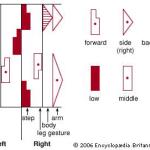Normalerweise frage ich im Unterricht bei anderen Lehrern nach der Benennungskonvention der Schritte. Ich kann nicht anders – ich bin ein deutscher Wissenschaftler und glaube, dass es sehr wichtig ist, dieselbe präzise und beschreibende Sprache zu sprechen. Die Sprache des Tangos ist natürlich Führen und Folgen, gute Balance und Projektion sowie die Fürsorge für unsere wertvollen Partner. Ohne diese Sprache gibt es keinen echten Tango. Im Tango dreht sich alles um Kommunikation und darum, eine nonverbale Form der Kommunikation und Verbindung zu finden. Das ist es, was wir lieben und wonach wir ständig streben. Normalerweise nutze ich die Hälfte meines Privatunterrichts und die andere Hälfte meines eigenen Trainings, um meine Fähigkeiten zu perfektionieren und meine Depression zu überwinden, wenn ich nur langsame Fortschritte mache.
Beim Üben und Unterrichten ist es wichtig, über Tango zu sprechen, und hier treten die Probleme auf. Es scheint, als gäbe es im Tango-Gespräch nicht viele gemeinsame Begriffe. Besonders argentinische Lehrer nach Benennungskonventionen zu fragen, ist frustrierend, da sie die traditionelle argentinische Lehrmethode, bei der nur Beispiele von Lehrern kopiert werden, meist entweder nicht kennen oder darauf verweisen.
Was sind also die Grundlagen in diesem Geschäft? Zunächst einmal gibt es den Grundschritt („el basico“), den scheinbar niemand liebt – aber jeder verwendet ihn im Unterricht (von ausländischen Touristen). Die Nummern der 8-Count-Grundschritte sind einzigartig und werden häufig im normalen Unterricht verwendet. „Tanz 1–5, führe Dame in Ocho vorwärts und…“ ist eine solche, häufig verwendete Anweisung, die die Schrittnummer des Basico verwendet. Die Benennung von Teilen des Grundschritts (oft auch folgendermaßen klassifiziert: 1–2 Einleitung, 3–5 Salida, 6–8 Auflösung) ist wiederum nicht sehr gebräuchlich, und der Begriff Salida kann in vielen logischen Kontexten verwendet werden.
Selbst diese Einzigartigkeit kann von vielen Lehrern beeinträchtigt werden, die mit dem zweiten Schritt beginnen. Ich muss zugeben, es gibt gute Gründe dafür, und ich beginne normalerweise auch mit dem Seitschritt (Apertura), aber mit Schritt Nummer 2 zu beginnen, ist nicht wirklich angenehm zu unterrichten…
Natürlich lernen wir Techniken im Unterricht und lernen, wie wir sie im Gesellschaftstanz anwenden können. Tango-Websites bieten meist eine Liste mit Tango-Techniken an. Hilfe hierzu gibt die Liste dieses Blogs oder zwei weitere sehr ausführliche Listen von anderen Websites an (die ich für sehr kompetent halte):
http://tango.5toll.com/tango-terminology/
http://www.tejastango.com/terminology.html
http://www.verytangostore.com/tango-terms.html
Typischerweise beschreiben diese Listen die Terminologie, die wir für die technischen Elemente und grundlegenden spanischen Wörter im Tango und im Spanischunterricht benötigen. Im Allgemeinen sind sie recht gut, aber die Definitionen einzelner Begriffe können unscharf sein. Sie sind hilfreich für den Tango-Alltag, aber nur begrenzt hilfreich beim Aufschreiben einer Choreografie.
Es ist wichtig, über Choreografie zu sprechen, denn manchmal muss man Schritte aufschreiben. Ich weiß, wir leben im Zeitalter der Videokamera, aber was ist, wenn der Lehrer des nächsten Workshops keine Videoaufnahmen erlaubt (das passiert zum Beispiel in einer sehr beliebten Tangoschule in Buenos Aires)? Oder wenn man eine Choreografie schreiben möchte, die genau zu einem bestimmten Musikstück passen muss (das ist die typische Situation bei der Vorbereitung auf einen Showtanz).
Choreografien für Tango sind typischerweise sehr persönlich und in der Regel nicht für die Öffentlichkeit bestimmt (ich habe im Internet kein gutes Beispiel für eine schriftliche Choreografie gefunden). Choreografien sind in der Regel nicht perfekt, da sie keine realen Körperbewegungen berücksichtigen. Professionelle Systeme dafür sind schwer zu beherrschen und wenig praxistauglich. Ein gutes Beispiel ist die Laban-Notation (korrekt: Labanotation) [1], die typischerweise im modernen Tanz verwendet wird. Bei Paartänzen werden die Schritte direkt choreografiert, zusammen mit zusätzlichen Informationen zu Grad und Richtung der Drehung, Tanzhaltung und Rhythmus.
Choreografien sind immer schwierig. Bei stark standardisierten Tänzen wie internationalen Gesellschaftstänzen, bei denen Schritte und Grad der Drehung sehr gut standardisiert sind, ist es etwas einfacher. Schwieriger wird es bei lateinamerikanischen Tänzen, und bei Tänzen mit geringem Standardisierungsgrad wie Salsa kann es eine echte Herausforderung sein. Beim Tango ist es ein echtes Problem, da es nicht viele klare Definitionen gibt, auf die wir zurückgreifen können. Das macht es schwierig, Choreografien für sich selbst zu schreiben, und noch schwieriger, wenn man sie für jemand anderen schreiben muss. Ich habe keine Ahnung, wie man dieses Problem (ohne Videokamera) lösen könnte. Um die Herausforderung zu erklären, hier als Beispiel ein Stück Choreografie, das ich geschrieben habe:
1-2 Basico SS 3 Basico, LF forw. Sacada SS Back/Side/Ocho for Lady QQS Close (forw. enrosque) / Bw Sacada QQ Lady side step S Calesita turning left with small bw. steps QQQQ Lady off axis (no step) RF to side S| Lady recover LF fw. S Lady LF bw. (cross system !) RF Sacada to side/back into open step of Lady S Lady RF bw. Stay on RF S Voleo (Lady) with LF S+ LF close, RF to Salida Americana (PP) +S Lady LF forw. into Sal.Americ. wait and uncross (receive Gancho w. left leg) SSS Giro left to Gancho Change weight to RF, LF close +S| Lady RF forw Ocho S+
Viel Spass beim Nachtanzen!
-Richard
Quellen
[1] http://en.wikipedia.org/wiki/Labanotation

